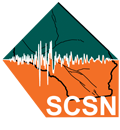Significant Events
- Largest event: M3.8, 09 Feb 2021 17:01:15 PST, (33.175, -115.613), depth 3.8km. 11km WNW of Calipatria, California.
- As of 11 Feb 2021, 10:19AM PST, the following event numbers have been recorded in the swarm:
- M≥3: 5
- M≥2: 23
- All M3 events recorded:
- M 3.0 09 Feb 2021 03:51:26 PST, (33.158, -115.633), 39546087
- M 3.8 09 Feb 2021 17:01:15 PST, (33.175, -115.613), 39546863
- M 3.2 09 Feb 2021 17:01:41 PST, (33.172, -115.600), 39546855
- M 3.1 09 Feb 2021 17:25:07 PST, (33.172, -115.608), 39546951
- M 3.8 09 Feb 2021 17:27:09 PST, (33.175, -115.612), 39546975
Swarm Numbers
- As of 11 Feb 2021, 10:33AM PST, we have recorded 111 events in the swarm (within a 20 km radius, and counting 5 days before largest event). The smallest event is magnitude 0.5. Many of the smaller events are still being analyzed and will be gradually added to the catalogue.
- More activity is expected in the next few days, swarm activity in Southern California can continue for hours, days, weeks, months or years. For more information on swarms please see our Swarm page.
Historical Seismicity
- Since our records began in 1932 we’ve had 98 events of M4 or greater within 10km of today’s event.
- The largest historic event was M6.2 on 1987/11/24.
- The most recent historic event was M4.0 on 04 Jan 2021.
Faults
- CFM fault associations: most likely Not associated with a CFM modeled fault (38%). Alternates: Elmore Ranch fault (28%), Other CFM faults (34%).*
Additional Information
- Links for: USGS earthquake page, ShakeMap, DYFI, waveforms.
- Visit our special reports page for further information on local notable earthquakes.
Below are the waveform data associated with the M3.8 at 17:01 PST 09/02/2021, as recorded in our Live Seismograms Feed.
*Earthquakes can occur both near or on major known faults, and in places where no clear fault zones are known. Using the statistical method of Evans et al. (in prep. 2019) the location and focal mechanism of this earthquake suggest the above association with modeled faults in the Community Fault Model (CFM) provided by the Southern California Earthquake Center (SCEC) and Harvard University. Note that the CFM fault association may be different from the nearby faults list. Differences may arise due to different fault databases, and because the CFM fault association uses the hypocenter with relation to subsurface 3-dimensional fault orientation models, while the nearby faults list utilizes mapped surface traces as they relate to the epicenter.
CFM Fault: SCEC CFM 5.0 Fault name and closest segment if available; The CFM is maintained by Harvard University, Dept of Earth & Planetary Sciences.
Probability: The probability in percent the earthquake is associated with this fault.
SCSN: Caltech/USGS Southern California Seismic Network
**U.S. Geological Survey and California Geological Survey, 2006, Quaternary fault and fold database for the United States, accessed 2015, from USGS web site: https://earthquake.usgs.gov/hazards/qfaults/
This information is subject to change as more up-to-date data become available.






